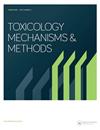二烯丙基硫化物减轻环磷酰胺诱导的大鼠肾病性脑病
IF 2.8
4区 医学
Q2 TOXICOLOGY
引用次数: 7
摘要
摘要二烯丙基硫化物(DAS)是一种大蒜衍生的有机硫化合物。本研究旨在评估DAS对环磷酰胺(CP)诱导的肾病性脑病的保护作用。DAS(100 mg/kg)口服给药4 天,60 最后一次给药后分钟,大鼠注射CP(150 mg/kg)。与CP治疗的大鼠相比,CP前DAS治疗显著降低了血清尿素、肌酸酐、钠、钾、钙、血尿素氮(BUN)、C反应蛋白(CRP)、白细胞介素-6(IL-6)、白介素-1β(IL-1ß)和肿瘤坏死因子-α(TNF-α)。DAS处理降低了肾组织中的丙二醛(MDA)、超氧化物歧化酶(SOD)和还原型谷胱甘肽(GSH)水平,并显著减弱了升高的神经递质N-甲基-D-天冬氨酸/三磷酸腺苷(NMDA),γ-氨基丁酸(GABA)水平,并显著恢复大脑中神经元一氧化氮(NO)水平和一氧化氮合酶(nNOS)活性。在CP前连续4天的DAS在脑和肾组织中显示出与CP处理的大鼠相当的胶质纤维酸性蛋白(GFAP)的中度阳性免疫组化表达。DAS对CP诱导的肾病性脑病具有肾脏和神经保护作用,因为它能够改善上述生化参数,这得到了组织病理学和免疫组织化学检查的支持。本文章由计算机程序翻译,如有差异,请以英文原文为准。
Diallyl sulfide alleviates cyclophosphamide-induced nephropathic encephalopathy in rats
Abstract Diallyl sulfide (DAS) is a garlic-derived organosulfur compound. The current study was planned to evaluate the protecting effects of DAS against cyclophosphamide (CP)-induced nephropathic encephalopathy. DAS (100 mg/kg) was orally administered for 4 days, 60 min after the last dose, rats were injected with CP (150 mg/kg). DAS treatment before CP significantly decreased serum urea, creatinine, sodium, potassium, calcium, blood urea nitrogen (BUN), C-reactive protein (CRP), interleukin-6 (IL-6), interleukin-1β (IL-1ß) and tumor necrosis factor-alpha (TNF-α) compared with CP-treated rats. DAS treatment decreased malondialdehyde (MDA) and increased superoxide dismutase (SOD) and reduced glutathione (GSH) levels in the renal tissues and significantly attenuated the elevated neurotransmitters N-methyl-D-aspartate/adenosine triphosphate (NMDA), γ-aminobutyric acid (GABA) levels and remarkably restored neuronal nitric oxide (NO) level and nitric oxide synthase (nNOS) activity in the brain compared to CP-treated rats. DAS for 4 consecutive days before CP showed moderate positive immunohistochemically expression of the glial fibrillary acidic protein (GFAP) in the brain and kidney tissues comparable to CP-treated rats. DAS afforded renal and neuroprotection against CP-induced nephropathic encephalopathy due to its capacity to ameliorates the afore-mentioned biochemical parameters which were supported by histopathological and immunohistochemically examination.
求助全文
通过发布文献求助,成功后即可免费获取论文全文。
去求助
来源期刊

Toxicology Mechanisms and Methods
TOXICOLOGY-
自引率
3.10%
发文量
66
期刊介绍:
Toxicology Mechanisms and Methods is a peer-reviewed journal whose aim is twofold. Firstly, the journal contains original research on subjects dealing with the mechanisms by which foreign chemicals cause toxic tissue injury. Chemical substances of interest include industrial compounds, environmental pollutants, hazardous wastes, drugs, pesticides, and chemical warfare agents. The scope of the journal spans from molecular and cellular mechanisms of action to the consideration of mechanistic evidence in establishing regulatory policy.
Secondly, the journal addresses aspects of the development, validation, and application of new and existing laboratory methods, techniques, and equipment. A variety of research methods are discussed, including:
In vivo studies with standard and alternative species
In vitro studies and alternative methodologies
Molecular, biochemical, and cellular techniques
Pharmacokinetics and pharmacodynamics
Mathematical modeling and computer programs
Forensic analyses
Risk assessment
Data collection and analysis.
 求助内容:
求助内容: 应助结果提醒方式:
应助结果提醒方式:


